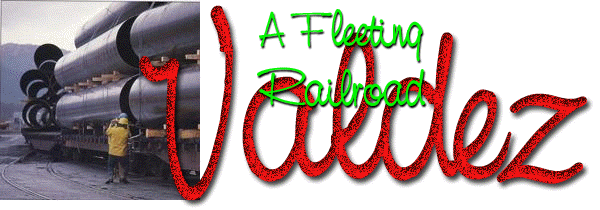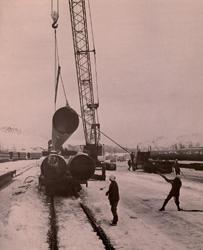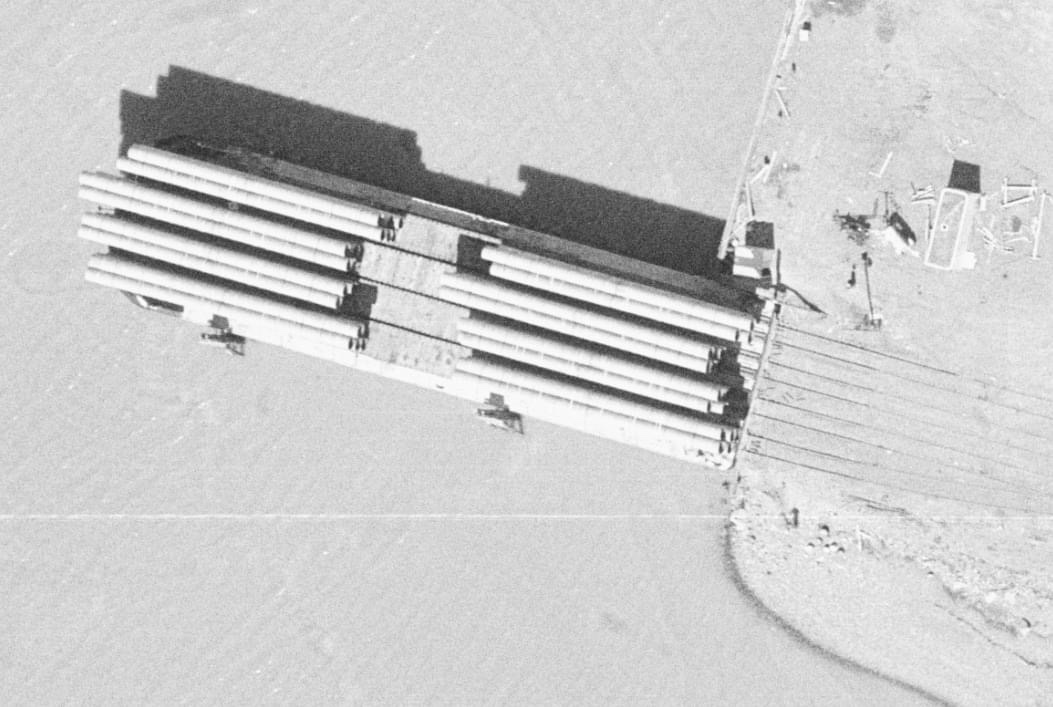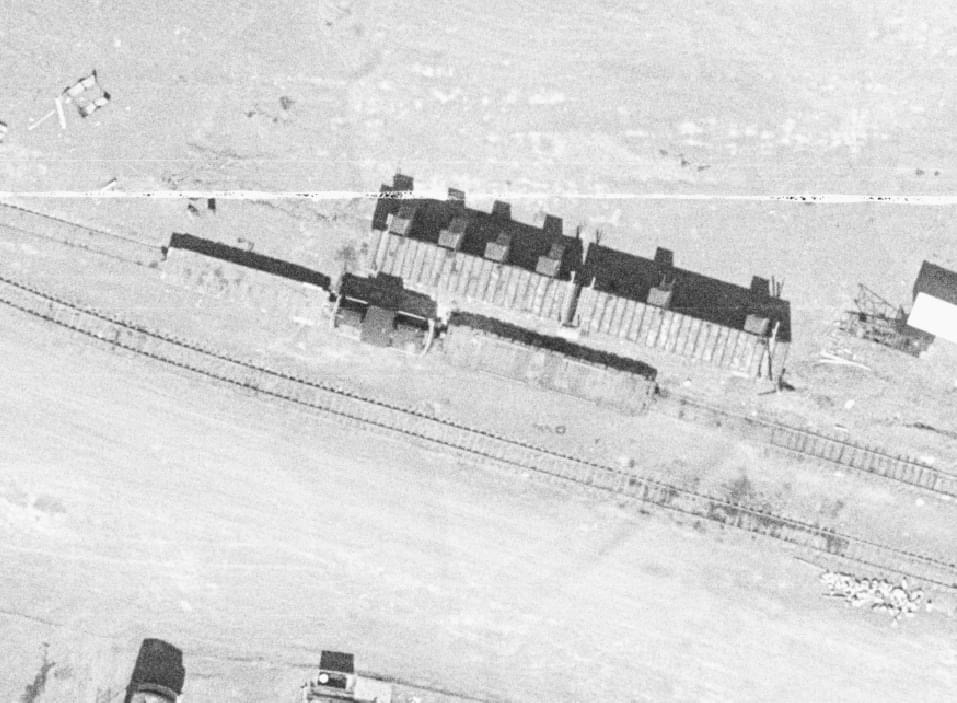
 |
Since April 1999 I've been collecting bits of information on the Alaska Railroad's presence in Valdez during the oil pipeline days. I have presented this material here using a lazy "copy and paste" format. This style enables me to present the information in the author's own words plus encourage further comment from others . Make sure and drop me an e-note if you have more information to contribute!
They used the ex Army 45 tonners. ARR acquired 4 of them in 1974, and retired them in 1983. Except for the Valdez work, and one that was leased to the North Pole refinery for a very short time, they saw little work. Alaska Railroad did not own SW-1500's. The last SW-1 left shortly before the little 45 tonners arrived.
by Curt Fortenberry, Alaska Railroad historian
It was not until the advent of the trans-Alaska oil pipeline that Valdez again became a major transportation center. During the pipeline construction, Valdez had a short railroad consisting of twp ex-ARR 45-tonners, no. 7324 and no. 7249 that worked on the dock.
by Howard Clifford, author
The Alaska Railroad has about 1/4 mile of trackage and a small barge slip in Valdez (Val-Deez). It is unused now but it did have approximately 1 1/2 miles of rail during the pipeline. The sections of the 40' x 48" pipe were welded together as 80' sections and coated in Valdez, then loaded on flat cars and brought to Whittier. Cars of equipment,cement and steel were loaded on the small 4 track barges for Valdez.
The Alaska Railroad had a small "Whiting" car mover in Valdez. As the traffic grew the ARR obtained 4, GE 50 ton locomotives from the US Army for use in Valdez. The ARR only managed to put 2 into service, the others cannibalized for spares. The locomotives then were used as switchers in the MAPCO refinery in North Pole until worn/burnt out. The Transportation Museum has one in it's display inventory. The "wild hair" for ARR train crews is that the Valdez locomotives were operated by the Operating Engineers Local 302, Heavy Equipment Operators.
by Frank Dewey, Alaska Railroad engineer
Alaska Railroad Valdez operations were mainly during the pipeline boom. There was a small yard there with maybe a total of five miles of track altogether. The barge slip. Barges carrying flat cars of pipe came into Valdez. Some of the pipe was off loaded there for the south end building of the pipeline, but most of it was brought in, off loaded, welded into 80 foot sections and reloaded and taken into either Seward or Anchorage or shipment into Fairbanks.
From a sign board at the Alaska Museum of Transportation and Industry
I got some back issues of old Extra 2200 South
magazines and in the Jan./Feb. 1974 issue on page 4 is the following:
"Four US Army GE 45T are on loan: 7249, 7324, 7331, 7356, arrived 2-3/74
from Ogden, Utah. Two will be used at Valdez, the southern end of the Alaska
pipeline on Prince William Sound, and two will be at Anchorage. Valdez is serviced
by Alaska Hydro-Train by barge from Whittier. At present a Whiting car mover
used at Valdez.
In 1968 vast reserves of oil and natural gas were discovered on the Alaska North Slope near Prudhoe Bay. The petroleum reservoir was determined to be twice the size of any other field in North America, and in 1969 the lease sale of oil fields yielded over $900 million. The 800-mi (1,287-km) Trans-Alaska pipeline from the Arctic North Slope to the ice-free port of Valdez opened in 1977 after bitter opposition from environmentalists, and oil has dominated the state economy ever since. Created in 1977, the Alaska Permanent Fund receives 25% of Alaska's oil royalty income. The fund is designed to provide the state with income after the oil reserves are depleted, and pays dividends to all residents. Offshore oil drilling in the Beaufort Sea has been opposed by environmentalists and the fishing industry.
by Jeff Childs, Alaska Railroad historian and former Secretary, Military Society of Model RR Engineers
Let me list the upgrades the ARR did from the pipeline boom. Many of them were necessary to handle the traffic. Most of these upgrades were funded from the increased revenue from traffic, not any fees generated from financial hocus pocus. I believe the Feds also kicked in some cash as well since they were the owners at the time.
Anyway this is probably not a complete list, but it is the stuff that jumps to mind right off the bat. They didn't really need a lot of new flat cars and gons as they had hundreds of the old 40' gons and quite a few 50' flats sitting around quite underutilized. All of this equipment was pretty old especially the gons, but the pipe came in 40' sections and fit in the old gons. I believe it was loaded six pieces to a car, but since it was 4' in diameter it was still a light load. They also welded some into 80' sections which was handled on flats with pipe centered on one car and idler flats between the loaded cars. They even bought four little GE 45 tonner side rod diesels which I believe shuffled the 80' long pipe on flats onto barges in Valdez which were unloaded at Whittier and shipped to Fairbanks.
Most of the hundreds of 40' gons were scrapped shortly after the pipeline boom ended. I think the ARR is much more lean on equipment now and probably would need additional power and cars to handle a big jump in traffic. Although the good news is if the gas pipeline were built it would likely justify the overhaul of the GP-40-2's and GP-49's which will largely become surplus or peak power after the new MAC's arrive. Short of such a project I think these units will be used mostly in the summer on gravel trains and be run to failure and stored or sold.
by Jason Kuehn, Alaska Railroad historian
After the 1964 earthquake, some of the lands that were heavily damaged as a result of the "64" quake in Valdez was taken over by the U.S. Government.
In the 1970's the Government excessed that property and the Alaska Railroad requested ownership-transfer of those lands (about 80 acres) to support the logistical movement of pipe for the Trans-Alaska pipeline. Since no other Federal activity (agency) was interested in those properties, the Alaska Railroad became the owner free and clear. We laid tracks from the dock in Valdez to the property where pipe was off-loaded and stored on the newly acquired property.
The land is still owned by the Railroad and is currently leased.
Jim Blasingame, Alaska Railroad Vice President, Corporate Affairs
As to the question, why was the pipe processed in Valdez and then sent via barge
to Whittier? You must first grasp the scope of the pipeline project and the
cost of infrastructure required to build it. Then you need to grasp the weather
along the route and the terrain northbound out of Valdez. The Richardson Hwy
is two lanes with steep grades up over Thompson Pass and it is real dicey in
the winter time. Divide 800 miles by 80 foot sections and figure out how many
truck loads that will be just for the pipe!
The challenge was to coordinate pipe delivery to several points on the pipeline corridor to allow simultaneous construction from several points, keeping the truck haul over public roads to a minimum. There was a pipe coating plant on the north slope where 40 ft sections were delivered by barge, welded cleaned coated and sent south down the North Slope Haul Road (Dalton Highway) that was closed to the public during the pipeline days. This was a gravel/ice road.
Pipe was delivered from Japan in 40 ft sections to Valdez on ships and off loaded for processing in the pipe coating plant located about one mile away. These plants were about 500 ft long built of folding sections of steel buildings and represented sizable investments.
Valdez being a deep water port could receive the raw pipe, and materials for the processing in bulk. As the specific sections of pipe were processed they were dispatched as needed from Valdez. Each section was built to design for a specific location in the line and varied in thickness, coating and finish depending on where it was to be used, at the top of a grade, bottom of a valley, under a river, buried or elevated above ground. Specialty sections with bends, joints, pump station hardware etc. were usually trucked north. Pipe required between Valdez and Delta Junction would move north over the highway.
More or less standard 80 ft sections were loaded on 40 ft flats with intermediate idlers and placed on barges for the trip from Valdez to Whittier. At Whittier they rolled across the car float and were made into trains that traveled through the tunnels to Anchorage. At Anchorage they were incorporated into regular north bound freight trains to Fairbanks. I am not sure where they were unloaded in Fairbanks but they could be distributed both North on the Dalton Hwy or South on the Richardson Hwy as needed.
I worked for Pictures Incorporated during the boom days, providing nightly movie entertainment in 13 construction camps up and down the line. As a result I had the privilege of traveling the length of the facility in both summer and winter consulting on equipment and facilities for the entertainment program. Few people on the project outside of top management got to see the whole project, and the sheer volume of equipment, materials and people was overwhelming. So moving all that stuff north out of Valdez on the Richardson Highway in addition to the construction on the south end would have been like a dose of Kayopectate.
As I recall there was a problem with the north bound sea lift that summer that would have taken more materials to the North Slope. Ice conditions or lack of barges for the sea lift resulted in more of the pipe coming into Valdez and being processed there resulting in a mini boom for the Alaska Railroad. There is reference to this in the Alaska Railroad Annual report of the period along with the only photo I have ever seen of the yard there. The photographer was the famous industrial photographer, Stanley McCutchen. There must be some other views.
by Pat Durand, Alaska Railroad historian
One thing that seems to get missed is that
the ARR put the track and barge slip at Valdez in service in 1965. It was put
in at the location of "old"Valdez, after the 1964 earthquake. It's
purpose was to make it easier to bring building materials in, for use in building
the "new" Valdez. The slip there was served by the Puget Sound - Alaska
Van Lines (Hydro-Trains) barges, from Seattle. PSAVL had seven barges in 1966.(remember
it was only in 1963 that the ARR started interchange via Whittier).
The ARR assigned a small Whiting trackmobile there as a car mover. After the
reconstruction of Valdez was done, it was served "as needed". When
pipeline construction was started, they used the existing barge slip, and extended
the tracks. Valdez was the large storage yard for the pipe, Pipe was also stored
at Prudhoe Bay, and Fairbanks. Remember that the pipe for the pipeline had been
purchased before final approval of the pipeline, it was stored for a few years
before construction started. When construction started, it was moved. The pipe
going north on the ARR was loaded on flatcars at Valdez, put on a railbarge,
sent to Whittier, and then up the ARR.
Pipe was in 40' lengths, most pre welded into 80' sections. Welding was done
at Valdez. There were also some 60' sections(? not many ?); and some special
bends, etc.
The pipe was loaded on 52' or 60' flatcars,
6 to a car;( 3 high, 2 across). Idler flatcars (50' or longer) were placed between
the loads, and at the ends of the loads.
by Don Marenzi, Alaska Railroad historian
 Quoting
from THE ANNUAL REPORT ON THE ALASKA RAILROAD, FISCAL YEAR 1976, "The Railroad's
Valdez facility was also active in the handling of pipeline freight with over
1300 carloads of 80-foot-long 48-inch diameter pipe being moved from Valdez to
Fairbanks via Whittier. This was a unique movement that the pipe was loaded on
rail cars in Valdez (photo at right), which were then loaded on rail barges and
towed 90 miles across the waters of Prince William Sound and off-loaded at the
Railroad's Whittier dock facility for final movement to Fairbanks."
Quoting
from THE ANNUAL REPORT ON THE ALASKA RAILROAD, FISCAL YEAR 1976, "The Railroad's
Valdez facility was also active in the handling of pipeline freight with over
1300 carloads of 80-foot-long 48-inch diameter pipe being moved from Valdez to
Fairbanks via Whittier. This was a unique movement that the pipe was loaded on
rail cars in Valdez (photo at right), which were then loaded on rail barges and
towed 90 miles across the waters of Prince William Sound and off-loaded at the
Railroad's Whittier dock facility for final movement to Fairbanks."
Here we have photo documentation of the Valdez yard facility and it's purpose. Loaded ships with 40 ft sections of 48" pipe would arrive in Valdez the site of a pipe coating plant. The pipe was then joined into 80 ft sections, cleaned and coated before being loaded on railcars in the yard. An idler flat was used between the loaded cars as seen in the background. The loaded cars were then rolled onto a rail barge and taken to Whittier for further shipment to Fairbanks. In this manner construction of the pipeline was being supplied on from both ends and the middle at Fairbanks.
Some one must have photos of the side rod GE 40 ton locomotives being used in the Valdez Yard. How about it? Here is another industrial opportunity for your model railroad. Valdez yard in one room connected by a roll around barge to Whittier in the next room! They must have shipped the locomotives back and forth the same way.
by Pat Durand, Alaska Railroad historian
Here is a Valdez track map from the Alaska Railroad track book of 1977. This would be the maximum amount of track they had there. The pipeline was finished in 1977. It still shows in the Alaska Railroad track book of 1980. A photo taken from an airplane in 1969 shows what appears to be all of this track in place. The photo was in a pipeline book, I believe.
Don Marenzi sent this aerial view of Valdez during the pipeline boom.
Excerpts from the book, 800 Miles to Valdez, The Building of the Alaska Pipeline by James P. Roscow:
"On the pipeline project, events were also coming in quick succession. Three days after the lease sale, on September 13, the first freighter arrived at Valdez with pipe from the Japanese steel mills. Deliveries continued at Valdez, Seward and Prudhoe Bay for the next two years. In all, some one hundred shiploads were needed. Each carrying more than eight miles of pipe in 40- and 60-foot sections. Some rough math tells how many single pieces of pipe that was. About 630 miles of pipe were delivered in 40-foot sections - more than 83,000 of them. About half of these were stored at Valdez, where shops were later set up to weld them into 80-foot 'double-joints' and wrap them with a protective coating before they were trucked out to the pipeline route. The rest of the 40-foot pipe went by train and truckload to another storage yard at Fairbanks, where it was also later double-jointed and coated." - page 29
In looking for alternatives to transfer oil from Prudhoe Bay to Valdez: "Extending the Alaska Railroad to the North Slope and moving the oil in tank cars was also suggested. Volume was a problem. The Department of Interior calculated that this would require sixty-three trains per day in each direction, one hundred cars in each train. This would be an environmental burden at best. Its economics were also poor, since the sixty-three northward-bound trains each day would all be 'dead-heading' - traveling empty." - page 71
In reference to the shipment of oil well supplies through frozen seas: "Another nineteen [barges], carrying cargo not needed so urgently, turned back to Seward and Anchorage, where their cargoes would be sent again by rail and truck." - page 150
Additional note from Russ Blood [6/26/06]:
I've found some info on the two engines that were here . Right now the best guess when they arrived is late 1974 or early 1975. No pictures as of yet. However, in going through old boxes we came across some material that identified them as G.E. Locomotive, Diesel Electric 45 Ton Reg. No. 7249 Ser. No.15713 and Reg No. 7324 Ser. No. 15244, and shipped from Defense Depot Ogden,Utah, Julian date of 4330. I've also found a few more photos to send. Our photos only seem to go to early '70s, I guess this is because my father and his partners sold to a larger company about June 1974.
I'm still going through old paper and found some more interesting items - stack of account billing records that are fairly complete spanning time frame of 8/15/66 to 12/23/68. These are from Slim Blood and Sons [my father's company] to The Alaska Railroad. They show date, trip number [starts at 46-N to 126-N] Consignee, Car No., also van numbers W.B. n.o. and dollar amounts. I don't have an accurate total of cars handled but seems to be approximately 250 or so. This may also include some loaded southbound.
Here's a somewhat random listing of car numbers.
It is interesting to note some of the railroads and types of
equipment represented:
GATX 54402
UTLX 51297
TCX 3206
ARR 415
ARR 10817
NP 97804
GN 37503
SP 330016
MILW 66423
PRR 612395
ARCX 2021
AT 66705
UP 112663
ATSF 75924
CNW 39071
SOO 5823
C&O 80565
This only shows about about a 2 1/2 year span of the 10 or 12 years it was in operation . I knew it as a busy place so it is interesting to see a number even for this short a time . Realize too that there was much more happening at the yard than just moving the cars on and off the barges. Track and switch maintenance, loading of trucks and more. Also, that pipeline activities starting in 1969/70 [a slow down from '70 to '73 because of land claims issues] increased traffic through the yard. The yard was expanded in size twice and grew to many acres. The tracks never went to the pipe storage yards but the last expansion brought it closer, my guess is within a 1/4 of a mile or less to the edge of one of the yards, [maybe I can find a map] and the small amount of pipe that was to go by railcar was hauled by truck from the pipe yard to the upper yard and loaded. So it would seem that quite a number of cars and barges were handled over the years. It would be interesting to get an accurate count.
Click here for Russ Blood's photos
Added 12/2/23 by Gabe Emerson:
Valdez finally got its railroad after the earthquake, with a barge dock and about 2 miles of track. During the pipeline boom there was some questionable scheme to bring in pipe sections, weld them together in Valdez, ship them back to Whittier on rail barges, and then haul them North on the Alaska Railroad. I've heard various justifications for this logistical tangle, but it sounds like one of those things Alaska comes up with to squeeze money out of clueless investors Down South :-) These aerial photos are from June 18, 1975.
You can see the rail yard and pipe welding areas, two switch engines (one is now at the MATI museum), and a barge loaded with flatcars of pipe.

Valdez rail yard in 1975

Railcar barge at Valdez, 1975.

GE switch engine with two flatcars, next to the Valdez rail yard office trailers.

Valdez pipe loading area.
Page created on 1/20/04 and last updated
12/2/23
© 2004-2006 by individual authors as noted above